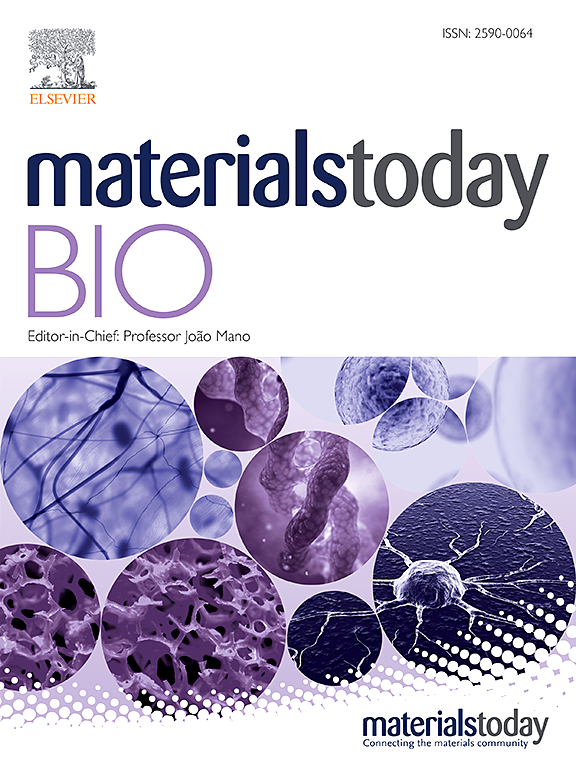Monosaccharide coating modulate the intracellular trafficking of gold nanoparticles in dendritic cells
IF 8.7
1区 医学
Q1 ENGINEERING, BIOMEDICAL
引用次数: 0
Abstract
Dendritic cells (DCs) have emerged as a promising target for drug delivery and immune modulation due to their pivotal role in initiating the adaptive immune response. Gold nanoparticles (AuNPs) have garnered interest as a platform for targeted drug delivery due to their biocompatibility, low toxicity and precise control over size, morphology and surface functionalization. Our investigation aimed to elucidate the intracellular uptake and trafficking of AuNPs coated with different combinations of monosaccharides (mannose, galactose, and fucose) in DCs. We used 30 unique polymer-tethered monosaccharide combinations to coat 16 nm diameter spherical gold nanoparticles and investigated their effect on DCs phenotype, uptake, and intracellular trafficking.
DCs internalized AuNPs coated with 100 % fucose, 100 % mannose, 90 % mannose +10 % galactose, and 80 % mannose +20 % galactose with highest efficiency. Flow cytometry analysis indicated that 100 % fucose-coated AuNPs showed increased lysosomal and endosomal contents compared to other conditions and uncoated AuNPs. Imaging flow cytometry further demonstrated that 100 % fucose-coated AuNPs had enhanced co-localization with lysosomes, while 100 % mannose-coated AuNPs exhibited higher co-localization with endosomes.
Furthermore, our data showed that the uptake of carbohydrate-coated AuNPs predominantly occurred through receptor-mediated endocytosis, as evidenced by a marked reduction of uptake upon treatment of DCs with methyl-β-cyclodextrins, known to disrupt receptor-mediated endocytosis. These findings highlight the utility of carbohydrate coatings to enable more targeted delivery of nanoparticles and their payload to distinct intracellular compartments in immune cells with potential applications in drug delivery and immunotherapy.

单糖包被调节树突状细胞内金纳米颗粒的运输。
树突状细胞(dc)由于其在启动适应性免疫应答中的关键作用而成为药物递送和免疫调节的有希望的靶标。金纳米颗粒(AuNPs)由于其生物相容性、低毒性和对大小、形态和表面功能化的精确控制而成为靶向药物递送的平台。我们的研究旨在阐明细胞内被不同组合的单糖(甘露糖、半乳糖和焦糖)包裹的AuNPs的摄取和运输。我们使用30种独特的聚合物系链单糖组合包裹直径为16纳米的球形金纳米颗粒,并研究了它们对dc表型、摄取和细胞内运输的影响。dc以最高效率内化涂有100%聚焦物、100%甘露糖、90%甘露糖+ 10%半乳糖和80%甘露糖+ 20%半乳糖的AuNPs。流式细胞术分析表明,100%聚焦包被的AuNPs与其他条件和未包被的AuNPs相比,溶酶体和内体含量增加。成像流式细胞术进一步表明,100%病灶包被的AuNPs与溶酶体的共定位增强,而100%甘露糖包被的AuNPs与核内体的共定位增强。此外,我们的数据表明,碳水化合物包被的AuNPs的摄取主要是通过受体介导的内吞作用发生的,正如甲基β-环糊精处理DCs后摄取的显著减少所证明的那样,已知甲基β-环糊精会破坏受体介导的内吞作用。这些发现强调了碳水化合物涂层的效用,使纳米颗粒及其有效载荷能够更有针对性地递送到免疫细胞内不同的细胞间隔,在药物递送和免疫治疗中具有潜在的应用前景。
本文章由计算机程序翻译,如有差异,请以英文原文为准。
求助全文
约1分钟内获得全文
求助全文
来源期刊

Materials Today Bio
Multiple-
CiteScore
8.30
自引率
4.90%
发文量
303
审稿时长
30 days
期刊介绍:
Materials Today Bio is a multidisciplinary journal that specializes in the intersection between biology and materials science, chemistry, physics, engineering, and medicine. It covers various aspects such as the design and assembly of new structures, their interaction with biological systems, functionalization, bioimaging, therapies, and diagnostics in healthcare. The journal aims to showcase the most significant advancements and discoveries in this field. As part of the Materials Today family, Materials Today Bio provides rigorous peer review, quick decision-making, and high visibility for authors. It is indexed in Scopus, PubMed Central, Emerging Sources, Citation Index (ESCI), and Directory of Open Access Journals (DOAJ).
 求助内容:
求助内容: 应助结果提醒方式:
应助结果提醒方式:


